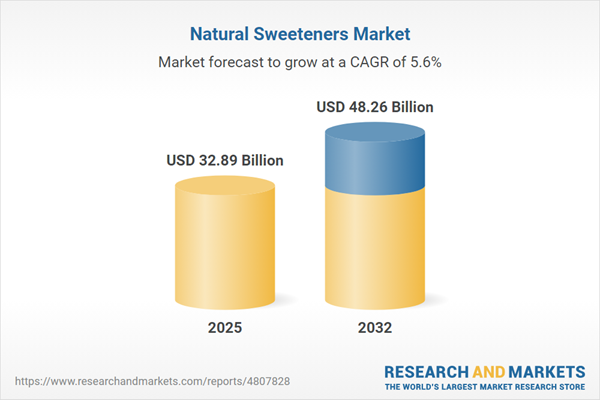Speak directly to the analyst to clarify any post sales queries you may have.
The natural sweeteners market is transforming rapidly as companies invest in sustainable sourcing, adapt to evolving regulations, and refine supply chains. Senior leaders face a critical juncture: adopting forward-looking strategies to secure resilience and competitiveness.
Market Snapshot: Natural Sweeteners Market Growth and Outlook
The global natural sweeteners market is set for significant expansion, with strong projections for the years ahead. It is forecast to reach USD 31.14 billion in 2024, followed by USD 32.89 billion in 2025, and is estimated to achieve USD 48.26 billion by 2032. The compound annual growth rate is calculated at 5.62%. This upward trend is fuelled by the demand from food and beverage, pharmaceutical, and personal care sectors seeking cleaner, healthier ingredients. As healthier product options grow in prominence, supply chain collaboration is increasing, and manufacturers prioritize traceable and transparent sourcing to meet tighter industry regulations and changing consumer expectations.
Scope & Segmentation: Comprehensive Overview of the Natural Sweeteners Market
- Type: Allulose, erythritol, monk fruit, stevia, tagatose, and xylitol each provide unique benefits in terms of taste, stability, and formulation, supporting specialized research and enabling differentiated applications for manufacturers and R&D.
- Application: Markets include animal feed, cosmetics, bakeries, confectionery, dairy, sauces, dressings, pharmaceuticals, nutraceuticals, and diverse food and beverage products, showing the adaptability of these sweeteners in both technical and consumer-facing roles.
- Form: Granular, liquid, powder, and tablet forms present options that enhance manufacturing efficiency and offer flexibility when introducing new product innovations for end-users.
- Distribution Channel: Food service, retail grocery, e-commerce, pharmacies, and specialty health outlets expand access for companies, supporting distribution models that address both digital growth and evolving consumer buying habits.
- Source: Plant-based extracts, sugar alcohols, and rare sugars processed via extraction and fermentation methods assist organizations in achieving sustainability goals and enhance traceability key to compliance and consumer assurance.
- Geographies: The natural sweeteners market has an established footprint across the Americas, Europe, Middle East, Africa, and Asia-Pacific, with major opportunities in China, India, and Southeast Asia through region-specific supply chain adaptations and targeted localization efforts.
- Company Coverage: Sector leaders such as Cargill, Ingredion, Tate & Lyle, Archer-Daniels-Midland, Roquette Frères, International Flavors & Fragrances, Corbion, Sensient Technologies, GLG Life Tech, and Global Sweeteners Holdings drive advancements in market portfolios, invest in process technology, and reinforce their territories in both developed and emerging regions.
Key Takeaways: Strategic Insights for Senior Leaders
- Transparent supply chains and robust digital traceability are essential for sustaining trust and credibility among clients, brand partners, and stakeholders across the market.
- Advancements in extraction and bioprocessing technologies allow for agile and scalable production, promoting innovation while ensuring products align with consumer and regulatory requirements.
- Implementation of regenerative agriculture practices and certified sourcing not only strengthens compliance but also communicates a clear commitment to responsible business conduct.
- Expanding into functional foods and animal nutrition segments opens new innovation streams, enabling organizations to access emerging growth opportunities and diversify revenue sources.
- Collaboration with technology-focused partners and processing experts is critical to improving operational efficiency, preparing for evolving compliance standards, and maintaining supply chain resilience among global uncertainties.
Tariff Impact: Responding to Policy Shifts in the United States
- Recent changes in United States tariffs are increasing raw material costs, prompting procurement leaders to diversify supplier bases and pursue local sourcing options.
- Strategic investments in domestic processing infrastructure support greater supply stability and reduce exposure to ongoing regulatory or trade risks.
- Agile supply chain management and sharp cost controls are now essential to limit operational impacts and ensure continued compliance as policies shift.
Methodology & Data Sources
This report is informed by primary research with procurement, compliance, and R&D decision-makers. All insights are cross-referenced against data from industry associations, regulatory bodies, peer-reviewed articles, and independent analytic sources to deliver actionable and validated intelligence for market stakeholders.
Why This Report Matters: Unlocking Value from Market Intelligence
- Supports executive decision-making with tailored recommendations to optimize compliance, boost supply chain flexibility, and embed sustainability across operations in the natural sweeteners market.
- Provides actionable insights enabling risk-managed procurement, driving innovation, and facilitating successful entry into new market segments or product portfolios.
- Delivers critical intelligence for implementing operational enhancements, guiding expansion initiatives, and adapting business models to keep pace with sector changes and regulatory complexity.
Conclusion
In-depth market insights equip company leaders to anticipate challenges, elevate operational performance, and secure a competitive, progressive stance within the evolving natural sweeteners industry.
Additional Product Information:
- Purchase of this report includes 1 year online access with quarterly updates.
- This report can be updated on request. Please contact our Customer Experience team using the Ask a Question widget on our website.
Table of Contents
3. Executive Summary
4. Market Overview
7. Cumulative Impact of Artificial Intelligence 2025
Companies Mentioned
The companies profiled in this Natural Sweeteners market report include:- Cargill, Incorporated
- Ingredion Incorporated
- Tate & Lyle PLC
- Archer-Daniels-Midland Company
- Roquette Frères S.A.
- International Flavors & Fragrances Inc.
- Corbion N.V.
- Sensient Technologies Corporation
- GLG Life Tech Corporation
- Global Sweeteners Holdings Limited
Table Information
| Report Attribute | Details |
|---|---|
| No. of Pages | 182 |
| Published | November 2025 |
| Forecast Period | 2025 - 2032 |
| Estimated Market Value ( USD | $ 32.89 Billion |
| Forecasted Market Value ( USD | $ 48.26 Billion |
| Compound Annual Growth Rate | 5.6% |
| Regions Covered | Global |
| No. of Companies Mentioned | 11 |









